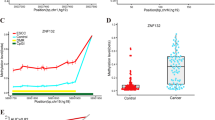Abstract
The aberrant expression of SPANXA1/A2 (sperm protein associated with the nucleus on the X-chromosome, family members A1/A2) has been observed in multi types of cancers. However, the roles of SPANXA1/A2 in head and neck squamous cell carcinoma (HNSCC) remain largely unknown. The expression of SPANXA1/A2 was evaluated via analyzing UCSC XENA and GEO databases. To dissect the underlying cause of silencing SPANXA1/A2-mediated suppression, cell migration and invasion were detected in SPANXA1/A2 manipulated cell lines. Western blot was performed to evaluate EMT-related factors. The methylation microarray data of SPANXA1/A2 in HNSCC from the UCSC XENA database were used to identify whether aberrant overexpressed SPANXA1/A2 is induced by aberrant DNA methylation. SPANXA1/A2 was highly expressed in tumor tissues and associated with poor survival of patients with HNSCC. Knockdown of SPANXA1/A2 inhibited migration and invasion abilities in both Cal-27 and SCC-9 cells through epithelial–mesenchymal transition (EMT) suppression. The SPANXA1/A2 expression negatively related to its DNA methylation level. SPANXA1/A2 DNA hypomethylation was associated with metastatic stage and poor survival of patients with HNSCC. A dose-dependent increase of SPANXA1/A2 mRNA was observed in both cal-27 and SCC-9 cells after treatment with 5-AZA-2′-deoxycytidine (5-AZA-CdR). We demonstrated that knockdown of SPANXA1/A2 obviously inhibited tumor cell migration and invasion through EMT suppression. DNA hypomethylation might be responsible for the aberrant SPANXA1/A2 overexpressing. SPANXA1/A2 may be used as a diagnosed and independent prognosis indicator of HNSCC, and knockdown of SPANXA1/A2 may present a new gene-based therapy for HNSCC.





Similar content being viewed by others
References
Mei Z, Huang J, Qiao B, Lam AK. Immune checkpoint pathways in immunotherapy for head and neck squamous cell carcinoma. Int J Oral Sci. 2020;12:16.
Sun W, Califano JA. Sequencing the head and neck cancer genome: implications for therapy. Ann N Y Acad Sci. 2014;1333:33–42.
Bauman JE, Austin MC, Schmidt R, Kurland BF, Vaezi A, Hayes DN, et al. ERCC1 is a prognostic biomarker in locally advanced head and neck cancer: results from a randomised, phase II trial. Br J Cancer. 2013;109:2096–105.
Kouprina N, Mullokandov M, Rogozin IB, Collins NK, Solomon G, Otstot J, et al. The SPANX gene family of cancer/testis-specific antigens: rapid evolution and amplification in African great apes and hominids. Proc Natl Acad Sci U S A. 2004;101:3077–82.
Westbrook VA, Schoppee PD, Diekman AB, Klotz KL, Allietta M, Hogan KT, et al. Genomic organization, incidence, and localization of the SPAN-x family of cancer-testis antigens in melanoma tumors and cell lines. Clin Cancer Res. 2004;10:101–12.
Hsiao YJ, Su KY, Hsu YC, Chang GC, Chen JS, Chen HY, et al. SPANXA suppresses EMT by inhibiting c-JUN/SNAI2 signaling in lung adenocarcinoma. Oncotarget. 2016;7:44417–29.
Chen Z, Li M, Yuan Y, Wang Q, Yan L, Gu J. Cancer/testis antigens and clinical risk factors for liver metastasis of colorectal cancer: a predictive panel. Dis Colon Rectum. 2010;53:31–8.
Maine EA, Westcott JM, Prechtl AM, Dang TT, Whitehurst AW, Pearson GW. The cancer-testis antigens SPANX-A/C/D and CTAG2 promote breast cancer invasion. Oncotarget. 2016;7:14708–26.
Salemi M, Calogero A, Zaccarello G, Castiglione R, Cosentino A, Catanuso M, et al. Expression of SPANX proteins in normal prostatic tissue and in prostate cancer. Eur J Histochem. 2010;54:180.
Zhou J, Xu D, Xie H, Tang J, Liu R, Li J, et al. miR-33a functions as a tumor suppressor in melanoma by targeting HIF-1alpha. Cancer Biol Ther. 2015;16:846–55.
Bo H, Gong Z, Zhang W, Li X, Zeng Y, Liao Q, et al. Upregulated long non-coding RNA AFAP1-AS1 expression is associated with progression and poor prognosis of nasopharyngeal carcinoma. Oncotarget. 2015;6:20404–18.
Kalashnikova EV, Revenko AS, Gemo AT, Andrews NP, Tepper CG, Zou JX, et al. ANCCA/ATAD2 overexpression identifies breast cancer patients with poor prognosis, acting to drive proliferation and survival of triple-negative cells through control of B-Myb and EZH2. Cancer Res. 2010;70:9402–12.
Zendman AJ, Zschocke J, van Kraats AA, de Wit NJ, Kurpisz M, Weidle UH, et al. The human SPANX multigene family: genomic organization, alignment and expression in male germ cells and tumor cell lines. Gene. 2003;309:125–33.
Westbrook VA, Diekman AB, Klotz KL, Khole VV, von Kap-Herr C, Golden WL, et al. Spermatid-specific expression of the novel X-linked gene product SPAN-X localized to the nucleus of human spermatozoa. Biol Reprod. 2000;63:469–81.
Urizar-Arenaza I, Osinalde N, Akimov V, Puglia M, Munoa-Hoyos I, Gianzo M, et al. SPANX-A/D protein subfamily plays a key role in nuclear organisation, metabolism and flagellar motility of human spermatozoa. Sci Rep. 2020;10:5625.
Huang J, Qin Y, Yang C, Wan C, Dai X, Sun Y, et al. Downregulation of ABI2 expression by EBV-miR-BART13-3p induces epithelial-mesenchymal transition of nasopharyngeal carcinoma cells through upregulation of c-JUN/SLUG signaling. Aging (Albany NY). 2020;12:340–58.
Raychaudhuri K, Chaudhary N, Gurjar M, D’Souza R, Limzerwala J, Maddika S, et al. 14-3-3sigma gene loss leads to activation of the epithelial to mesenchymal transition due to the stabilization of c-Jun protein. J Biol Chem. 2016;291:16068–81.
Yilmaz-Ozcan S, Sade A, Kucukkaraduman B, Kaygusuz Y, Senses KM, Banerjee S, et al. Epigenetic mechanisms underlying the dynamic expression of cancer-testis genes, PAGE2, -2B and SPANX-B, during mesenchymal-to-epithelial transition. PLoS One. 2014;9:e107905.
Acknowledgements
This work was supported by the National Natural Science Foundation of China (No. 31472054, No. 81974297) and the National Key Research and Development Program of China (2016YFC1000600).
Author information
Authors and Affiliations
Corresponding authors
Ethics declarations
Conflict of interest
There are no conflicts of interest to disclose.
Ethical approval
This article does not contain any studies with human participants or animals performed by any of the authors.
Informed consent
None.
Additional information
Publisher’s Note
Springer Nature remains neutral with regard to jurisdictional claims in published maps and institutional affiliations.
Rights and permissions
About this article
Cite this article
Li, J., Bo, H., Zhu, F. et al. Hypomethylated SPANXA1/A2 promotes the metastasis of head and neck squamous cell carcinoma. Med Oncol 37, 112 (2020). https://doi.org/10.1007/s12032-020-01441-2
Received:
Accepted:
Published:
DOI: https://doi.org/10.1007/s12032-020-01441-2




